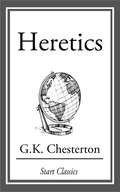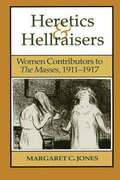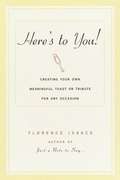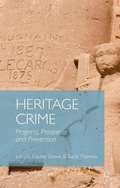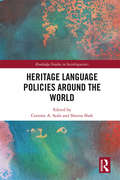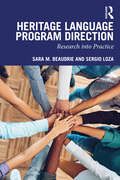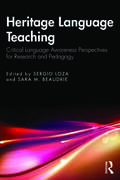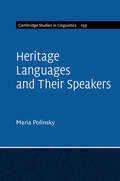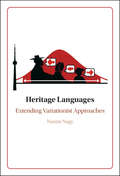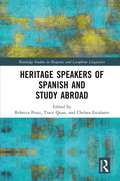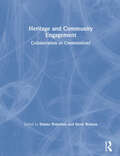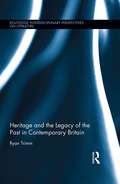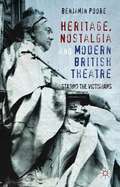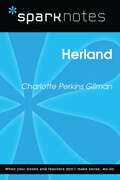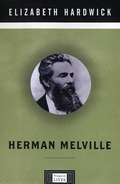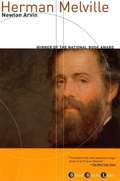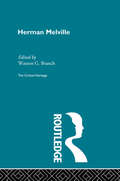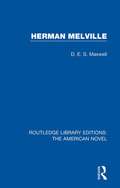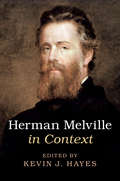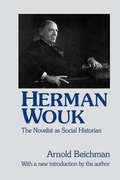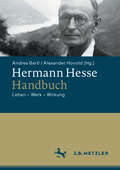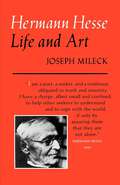- Table View
- List View
Heretics
by G. K. ChestertonG. K. Chesterton, the "Prince of Paradox," is at his witty best in this collection of twenty essays and articles from the turn of the twentieth century. Focusing on "heretics" -- those who pride themselves on their superiority to conservative views -- Chesterton appraises prominent figures who fall into that category from the literary and art worlds. Luminaries such as Rudyard Kipling, George Bernard Shaw, H. G. Wells, and James McNeill Whistler come under the author's scrutiny, where they meet with equal measures of his characteristic wisdom and good humor. In addition to incisive assessments of well-known individuals ("Mr. Rudyard Kipling and Making the World Small" and "Mr. H. G. Wells and the Giants"), these essays contain observations on the wider world. "On Sandals and Simplicity," "Science and the Savages," "On Certain Modern Writers and the Institution of the Family," "On Smart Novelists and the Smart Set," and "Slum Novelists and the Slums" reflect the main themes of Chesterton's life's work. Heretics roused the ire of some critics for censuring contemporary philosophies without providing alternatives; the author responded a few years later with a companion volume, Orthodoxy. Sardonic, jolly, and generous, both books are vintage Chesterton.
Heretics and Hellraisers: Women Contributors to The Masses, 1911-1917
by Margaret C. JonesThe Masses was the most dynamic and influential left-wing magazine of the early twentieth century, a touchstone for understanding radical thought and social movements in the United States during that era. As a magazine that supported feminist issues, it played a crucial role in shaping public discourse about women's concerns. Women editors, fiction writers, poets, and activists like Mary Heaton Vorse, Louise Bryant, Adriana Spadoni,Elsie Clews Parsons, Inez Haynes Gillmore, and Helen Hull contributedas significantly to the magazine as better-known male figures. In this major revisionist work, Margaret C. Jones calls for reexamination of the relevance of Masses feminism to that of the 1990s. She explores women contributors' perspectives on crucial issues: patriarchy, birth control, the labor movement, woman suffrage, pacifism, and ethnicity. The book includes numerous examples of the writings and visual art of Masses women and a series of biographical/bibliographical sketches designed to aid other researchers.
Here’s to you!: Creating Your Own Meaningful Toast or Tribute for any Occasion
by Florence IsaacsIs your best friend getting married? Is your boss retiring? Are your parents celebrating their thirtieth anniversary? On these and many other occasions, you’ll probably need to give a toast–and you might well have trouble finding the right words. Fear no more. The bestselling author ofJust a Note to Say…is back withHere’s to You!, an invaluable guide to giving meaningful, personal toasts and tributes on any occasion, including: weddings, graduations, anniversaries, birthdays, holidays, roasts, retirements, promotions, award ceremonies, office gatherings, professional anniversaries "If anyone is going to stand up at your wedding and give a toast, you’ll want to make sure they’ve readHere’s To You!first. It’s chock-full of funny, warm, poignant real-life toasts, as fun to read as they must have been to hear. Any toast-writer will find his creative juices flowing the minute he finishes reading. " –Antonia van der Meer, editor-in-chief,Modern Bride
Heritage Crime
by Louise Grove Suzie ThomasBringing together leading academics and practitioners from across the globe, this unique collection explores the emerging field of heritage crime studies. Moving beyond the traditional focus on illicit antiquities, the volume identifies the diversity of crimes that affect heritage and outlines various approaches to prevention.
Heritage Language Policies around the World (Routledge Studies in Sociolinguistics)
by Corinne A. Seals Sheena ShahHeritage language policies define the context in which heritage languages are maintained or abandoned by communities, and this volume describes and analyzes international policy strategies, as well as the implications for the actual heritage language speakers. <P><P>This volume brings together heritage language policy case studies from around the world, foregrounding globalization by covering five regions: the Americas, Europe, Africa, Asia, and Australasia. The countries profiled include the United States, Canada, Argentina, Norway, Sweden, Ireland, Uganda, Namibia, Morocco, Japan, South Korea, Singapore, New Zealand, Australia, and Fiji. This volume also highlights an expanded definition of ‘heritage language’, choosing to focus on individual and community identities, and therefore including both Indigenous and immigrant languages. <P><P>Focusing specifically on language policy relating to heritage languages, the chapters address key questions such as <li>Are heritage languages included or excluded from the national language policy discourse? <li>What are the successes and shortcomings of efforts to establish heritage language policies? <li>What is the definition of ‘heritage language’ in official usage by the local/regional government and stakeholders? <li>How are these language policies perceived by the actual heritage language communities?
Heritage Language Program Direction: Research into Practice
by Sergio Loza Sara M. BeaudrieThis innovative text presents an introduction to different facets of building and leading language education programs at the university level to meet the needs of students who are minority speakers of a heritage language (HL) – also known as community or home languages. Providing a unique synthesis of theory and empirical research, Sara Beaudrie and Sergio Loza authoritatively illustrate and guide the reader through the main issues that program directors face from the early stage of program conceptualization and creation through later stages of program management and evaluation. The book keys in on the diverse considerations and skills involved in this leadership work – including advocacy and fund-raising, placement, curriculum development and assessment, teacher preparation and student advocacy – and offers an array of practical advice and pedagogical features. This is an invaluable resource for advanced students and scholars of applied linguistics and education, as well as future and current language program administrators in institutions of higher education, for understanding the benefits of specialized HL courses, for blazing a trail in future research in this domain, and for forging a path to solidified institutional recognition and support for HL education.
Heritage Language Program Direction: Research into Practice
by Sergio Loza Sara M. BeaudrieThis innovative text presents an introduction to different facets of building and leading language education programs at the university level to meet the needs of students who are minority speakers of a heritage language (HL) – also known as community or home languages.Providing a unique synthesis of theory and empirical research, Sara Beaudrie and Sergio Loza authoritatively illustrate and guide the reader through the main issues that program directors face from the early stage of program conceptualization and creation through later stages of program management and evaluation. The book keys in on the diverse considerations and skills involved in this leadership work – including advocacy and fund-raising, placement, curriculum development and assessment, teacher preparation and student advocacy – and offers an array of practical advice and pedagogical features.This is an invaluable resource for advanced students and scholars of applied linguistics and education, as well as future and current language program administrators in institutions of higher education, for understanding the benefits of specialized HL courses, for blazing a trail in future research in this domain, and for forging a path to solidified institutional recognition and support for HL education.
Heritage Language Teaching: Critical Language Awareness Perspectives for Research and Pedagogy
by Sergio LozaThis innovative, timely text introduces the theory, research, and classroom application of critical approaches to the teaching of minoritized heritage learners, foregrounding sociopolitical concerns in language education. Beaudrie and Loza open with a global analysis, and expert contributors connect a focus on speakers of Spanish as a heritage language in the United States to broad issues in heritage language education in other contexts – offering an overview of key concepts and theoretical issues, practical pedagogical guidance, and field-advancing suggestions for research projects. This is an invaluable resource for advanced students and scholars of applied linguistics and education, as well as language program administrators.
Heritage Languages and their Speakers (Cambridge Studies in Linguistics #159)
by Maria PolinskyThis book provides a pioneering introduction to heritage languages and their speakers, written by one of the founders of this new field. Using examples from a wide range of languages, it covers all the main components of grammar, including phonetics and phonology, morphology and morphosyntax, semantics and pragmatics, and shows easy familiarity with approaches ranging from formal grammar to typology, from sociolinguistics to child language acquisition and other relevant aspects of psycholinguistics. The book offers analysis of resilient and vulnerable domains in heritage languages, with a special emphasis on recurrent structural properties that occur across multiple heritage languages. It is explicit about instances where, based on our current knowledge, we are unable to reach a clear decision on a particular claim or analytical point, and therefore provides a much-needed resource for future research.
Heritage Languages: Extending Variationist Approaches
by Naomi NagyHeritage language speakers often feel discouraged from using their heritage language because they are told they do not speak it well. This book offsets such views by investigating heritage language variation and change across generations in eight languages spoken in Toronto. It introduces new methodology to help readers understand and apply variationist sociolinguistic approaches to quantitatively analyze spontaneous speech. This approach, based on a corpus of 400+ speakers, shows that variation and change across the grammar of heritage languages resemble the patterns in hegemonic majority languages, contrasting with the simplification/attrition patterns in experimental heritage language studies. Chapters compare patterns across generations, across languages, across ten variables in Cantonese, and between indexical and non-indexical patterns. Heritage language speakers are quoted, showing that this research increases heritage language usage and pride. Providing a tool for language revitalization, this book is essential reading for anyone interested in learning about and/or conducting research on heritage languages.
Heritage Speakers of Spanish and Study Abroad (Routledge Studies in Hispanic and Lusophone Linguistics)
by Rebecca PozziHeritage Speakers of Spanish and Study Abroad is an edited volume that provides emerging research on heritage speakers of Spanish in immersion contexts in theoretical, empirical, and programmatic terms. This edited collection seeks to expand our understanding of heritage speakers of Spanish by incorporating research on their linguistic, sociolinguistic, and pragmatic development during and after a sojourn abroad, by discussing the complexities of their identity formation and negotiation during immersive stays, and by highlighting programmatic innovations that could be leveraged to better serve diverse learners in study abroad contexts. This volume advances the fields of both heritage language education and research on immersion study in a variety of ways, and will be of interest to scholars of applied linguistics, sociolinguistics, second language acquisition, and educational linguistics, especially those interested in study abroad programming and Spanish for heritage speakers.
Heritage and Community Engagement: Collaboration Or Contestation?
by Emma Waterton Steve WatsonThis book is about the way that professionals in archaeology and in other sectors of heritage interact with a range of stakeholder groups, communities and the wider public. Whilst these issues have been researched and discussed over many years and in many geographical contexts, the debate seems to have settled into a comfortable stasis wherein it is assumed that all that can be done by way of engagement has been done and there is little left to achieve. In some cases, such engagement is built on legislation or codes of ethics and there can be little doubt that it is an important and significant aspect of heritage policy. This book is different, however, because it questions not so much the motivations of heritage professionals but the nature of the engagement itself, the extent to which this is collaborative or contested and the implications this has for the communities concerned. Furthermore, in exploring these issues in a variety of contexts around the world, it recognises that heritage provides a source of engagement within communities that is separate from professional discourse and can thus enable them to find voices of their own in the political processes that concern them and affect their development, identity and well-being. This book was published as a special issue of the International Journal of Heritage Studies.
Heritage and the Legacy of the Past in Contemporary Britain (Routledge Interdisciplinary Perspectives on Literature)
by Ryan TrimmBringing together heritage studies and literary studies, this book examines heritage as a ubiquitous trope in contemporary Britain, a seemingly inescapable figure for relations to the past. Inheritance has been an important metaphor for characterizing cultural and political traditions since the 1970s, but one criticized for its conservatism and apparent disinheritance of "new" Britons. Engaging with contemporary literary and cinematic texts, the book interrogates metaphoric resonances: that bestowing past, receiving present, and transmitted bounty are all singular and unified; that transmission between past and present is smooth, despite heritage depending on death; that the past enjoins the present to conserve its legacy into the future. However, heritage offers an alternative to modern market-driven relations, transactions stressing connection only through a momentary exchange, for bequest resembles gift-giving and connects past to present. Consequently, heritage contains competing impulses, subtexts largely unexplored given the trope’s lapse into cliché. The volume charts how these resonances developed, as well as charting more contemporary aspects of heritage: as postmodern image, tourist industry, historic environment, and metaculture. These dimensions develop the trope, moving it from singular focus on continuity with the past to one more oriented around different lines of relation between past, present, and future. Heritage as a trope is explored through a wide range of texts: core accounts of political theory (Locke and Burke); seminal documents within historic conservation; phenomenology and poststructuralism; film and television (Merchant-Ivory, Downton Abbey); and a broad range of contemporary fiction from novelists including Zadie Smith, Julian Barnes, Hilary Mantel, Sarah Waters, Alan Hollinghurst, Peter Ackroyd, and Helen Oyeyemi.
Heritage, Nostalgia and Modern British Theatre
by Benjamin PooreThe Victorians, having once been seen as 'them', the age responsible for the mistakes of the past, were transformed by the new theatrical forms of the 1960s into 'us', a metaphor for what the nation thinks (and fears) about itself. And, since the 1980s and the rise of new biographical forms in the theatre, the emphasis has shifted further, from 'we' to 'me': plays about individuals, great and small, and their struggles for personal validation. This study argues powerfully that the stage portrayal of the Victorians in recent times is a key reference point in understanding notions of Britishness, heritage and nostalgia, and the profound politicisation of national identity over the last four decades. Using many examples drawn from theatre archives, and throwing new light on works by canonical playwrights like Bond, Edgar, and Churchill, it charts the decline in class-based narratives of the British people and the move towards plays reflecting a more atomised, individuated society, preoccupied with identity and the past but no longer able to provide a convincing account of itself as a nation.
Herland (SparkNotes Literature Guide Series)
by SparkNotesHerland (SparkNotes Literature Guide) by Charlotte Perkins Gilman Making the reading experience fun! Created by Harvard students for students everywhere, SparkNotes is a new breed of study guide: smarter, better, faster.Geared to what today's students need to know, SparkNotes provides:chapter-by-chapter analysis explanations of key themes, motifs, and symbols a review quiz and essay topics Lively and accessible, these guides are perfect for late-night studying and writing papers.
Herman Melville
by Elizabeth HardwickA single novel, an eternal classic, established him as a founding father of American literature. Now, a century after his death, a new popular surge of interest in Herman Melville calls for Elizabeth Hardwick's rich analysis of "the whole of Melville's works, uneven as it is, and the challenging shape of his life ... a story of the creative history of an extraordinary American genius. "Hardwick's superb critical interpretation and award-winning novelistic flair reveal a former whaleship deckhand whose voyages were the stuff of travel romances that seduced the public. Later, a self-described "thought-diver" into "the truth of the human heart," Melville harbored a bitterness that knew no bounds when that same public failed to embrace his masterwork, Moby-Dick. Invaluable for enthusiasts of American literature, Herman Melville is itself a masterpiece of critical commentary in the tradition of D. H. Lawrence's Studies in Classic American Literature.
Herman Melville
by Newton ArvinOne of America's most enigmatic literary figures, Herman Melville lived a life full of adventure, hardship, and moral conflict. Known for his nautical escapades, Melville first went to sea in his early twenties, sailing to England and then Polynesia where he found himself fleeing from cannibals, joining a mutiny, and frolicking with naked islanders. His novels were, for the most part, unsuccessful and misunderstood, and later in life he had to accept work as a low-level customs agent to support his wife and children. His only close friend was Nathaniel Hawthorne to whom he dedicated Moby-Dick. Newton Arvin's biography captures the troubled, often reclusive man whose major works include Typee, Omoo, Bartleby the Scrivener, Billy Budd, and his indisputable masterpiece, Moby-Dick. <P><P> Winner of the National Book Award
Herman Melville (Critical Heritage Ser.)
by Watson G. BranchThis set comprises 40 volumes covering 19th and 20th century European and American authors. These volumes will be available as a complete set, mini boxed sets (by theme) or as individual volumes. This second set complements the first 68 volume set of Critical Heritage published by Routledge in October 1995.
Herman Melville (Routledge Library Editions: The American Novel #10)
by D. E. MaxwellIn this fascinating and revealing book, first published in 1968, Maxwell examines the life and work of Herman Melville. By dividing extracts of Melville’s work in chronological order, the sections clearly illustrate the various facets of Melville’s technique and thought as it evolves. This title is essential reading for students of American Literature.
Herman Melville in Context (Literature in Context)
by Kevin J. Hayes"Herman Melville in Context provides the fullest introduction in one volume to the multifaceted life and times of Herman Melville, a towering figure in nineteenth-century American and world literature. The book grounds the study of Herman Melville's writings to the world that influenced their composition, publication and recognition, making it a valuable resource to scholars, teachers, students and general readers. Bringing together contributions covering a wide range of topics, the collection of essays covers the geographical, social, cultural and literary contexts of Melville's life and works, as well as its literary reception. Herman Melville in Context will enable readers to approach Melville's writings with fuller insight, and to read and understand them in a way that approximates the way they were read and understood in his time"--
Herman Melville: A Biography
by Leon HowardThis title is part of UC Press's Voices Revived program, which commemorates University of California Press’s mission to seek out and cultivate the brightest minds and give them voice, reach, and impact. Drawing on a backlist dating to 1893, Voices Revived makes high-quality, peer-reviewed scholarship accessible once again using print-on-demand technology. This title was originally published in 1951.
Herman Wouk: The Novelist as Social Historian
by Arnold BeichmanArnold Beichman's comprehensive study of the writings of Herman Wouk, one of America's leading writers, shows how Wouk's plays and novels exemplify an extraordinary and often highly perceptive preoccupation with American society in war and in peace. Situating Wouk in the same literary tradition as Cervantes, Richardson, Balzac, and Dickens, Beichman demonstrates that Wouk's novels have strong plots, moralist outcomes, and active--essentially positive--characters. The new introduction serves to bring Wouk's work over the past two decades into the reckoning.Making extensive use of Wouk's personal papers and manuscripts as well as personal interviews with him, Beichman's focus is on the social and literary qualities of Wouk's work. In particular, he examines eight novels including War and Remembrance and The Winds of War; The Traitor, one of his three plays; and two moral tracts on Judaism. Wouk has written four more novels, including his latest, A Hole in Texas, his twelfth.Beichman portrays Wouk as one of the few living novelists concerned with virtue, and sees his work as against the mainstream of contemporary American novelists. These, he argues, have eschewed such elements of the traditional novel as invention, coincidences, surprises, suspense, and a moral perspective more presumed than examined.
Hermann Hesse-Handbuch: Leben – Werk – Wirkung
by Céline Burget Marlene Hartmann Jule SpindlerErstmals liegt mit dem Hermann Hesse-Handbuch ein umfassend informierendes Nachschlagewerk zu diesem faszinierenden Autor vor. Hermann Hesse (1877–1962) war und ist ein literarisches Phänomen eigener Ordnung. Aus dem Geist der Spätromantik und des lyrischen Impressionismus hervorgegangen, hat sein Werk in den ersten Jahrzehnten des 20. Jahrhunderts vor allem mit Künstler-Erzählungen und coming of age-Romanen wie dem Peter Camenzind, dem Demian und später dem Steppenwolf die Wertschätzung einer begeisterten Leserschaft erreicht. Ein internationaler Höhenflug war seiner indischen Siddhartha-Figur postum durch die us-amerikanische Hippiebewegung der späten 1960er Jahre beschieden. Hesses langlebige Popularität, die ihn neben Brecht zu einer frühen Gallionsfigur des Suhrkamp-Programms werden ließ, traf im intellektuellen Feuilleton und in der akademischen Welt oftmals auf eher abschätzige Beurteilungen. Dieses bemerkenswerte Spannungsverhältnis bildet einen der Ansatzpunkte, mit dem die in diesem Handbuch versammelten Beiträge die Werk- und Wirkungsgeschichte des schwäbisch-schweizerischen Nobelpreisträger nachzeichnen Ein zweites, nicht minder ergiebiges Leitthema des Bandes bildet Hesses staunenswerte künstlerische Vielseitigkeit. Obwohl schon zu Lebzeiten ein Klassiker, ist das gesamte Spektrum des Dichters, Romanciers, Essayisten, Kritikers und Briefeschreibers, darüber hinaus noch des Malers und Aquarellisten kaum zu ermessen und kann hier dank facettenreicher Einzelstudien in seiner produktiven Vielfalt entdeckt werden.
Hermann Hesse: Life and Art
by Joseph Mileck"A critical biography far surpassing the previous ones."--Times Higher Education Supplement "There are to be sure many writers whose biographies are more interesting than their fiction but Hesse is not one of these. He led a long and sometimes eventful life with marital tensions, traveL controversy, crises, even some thoughts of suicide and a period of time as a student in a home for retarded and unmanageable. In addition, there was his search which led him through the culture and arts of West and East, his views of politics and society, of psychology and philosophy. The difference between Hesse and other writers is that virtually every shred and patch of his life was brought into his writing, his fiction particularly. 'He had to write about himself and there is little of what he wrote that is not confessional in form and therapeutic in function.' Autobiography is the very matter of his work. Mileck's contribution is to extend and fill out the evidence of his life, his psychoanalysis, his drive toward self-realization which was the very engine of his being, to show the raw material and thus to invite readers to see how it was transmuted, transfigured, fantasized, poeticized, symbolized."--Los Angeles Times "Hesse was a prolific author for some 60 years, and his mind drew everything it contemplated into his private wars between flesh and spirit. objectivity and subjectivity, the longings for society and isolation. No one is better qualified to disentangle this abundance than Mileck, compiler of the huge two-volume Hesse bibliography. For completeness, then, no biography in English compares." --Kirkus Reviews "Mileck provides his own translations of the German quotations from Hesse's works, and the eight interpretive chapters are thoroughly indexed, making the work readily accessible to researchers and students concerned with specific Hesse questions and themes. This very readable book also contains a number of exceptional photographs, which, together with Mileck's fervor and understanding of the author, help create a living image of Hesse the man and the artist."--Choice "Professor Mileck . .. brings to his task an acquaintanceship with Hesse's published and unpublished writings .. . which borders on omniscience. This is a literary biography which concentrates on the works and looks at the life of its subject briefly and always in relation to its involvement with the works . . . [This] is true scholarship, which does not make the book less readable and accessible to the general public. . . . a solid and valuable book which should make it easier . . . to bring [Hesse] back into the orbit of serious appreciation in the English-speaking world." --Books and Bookmen
